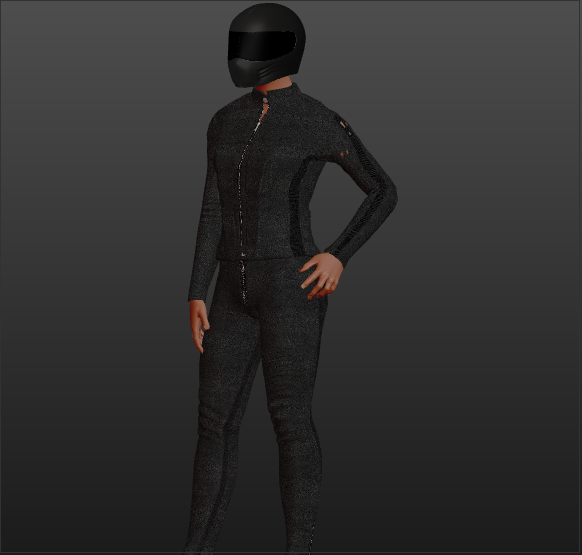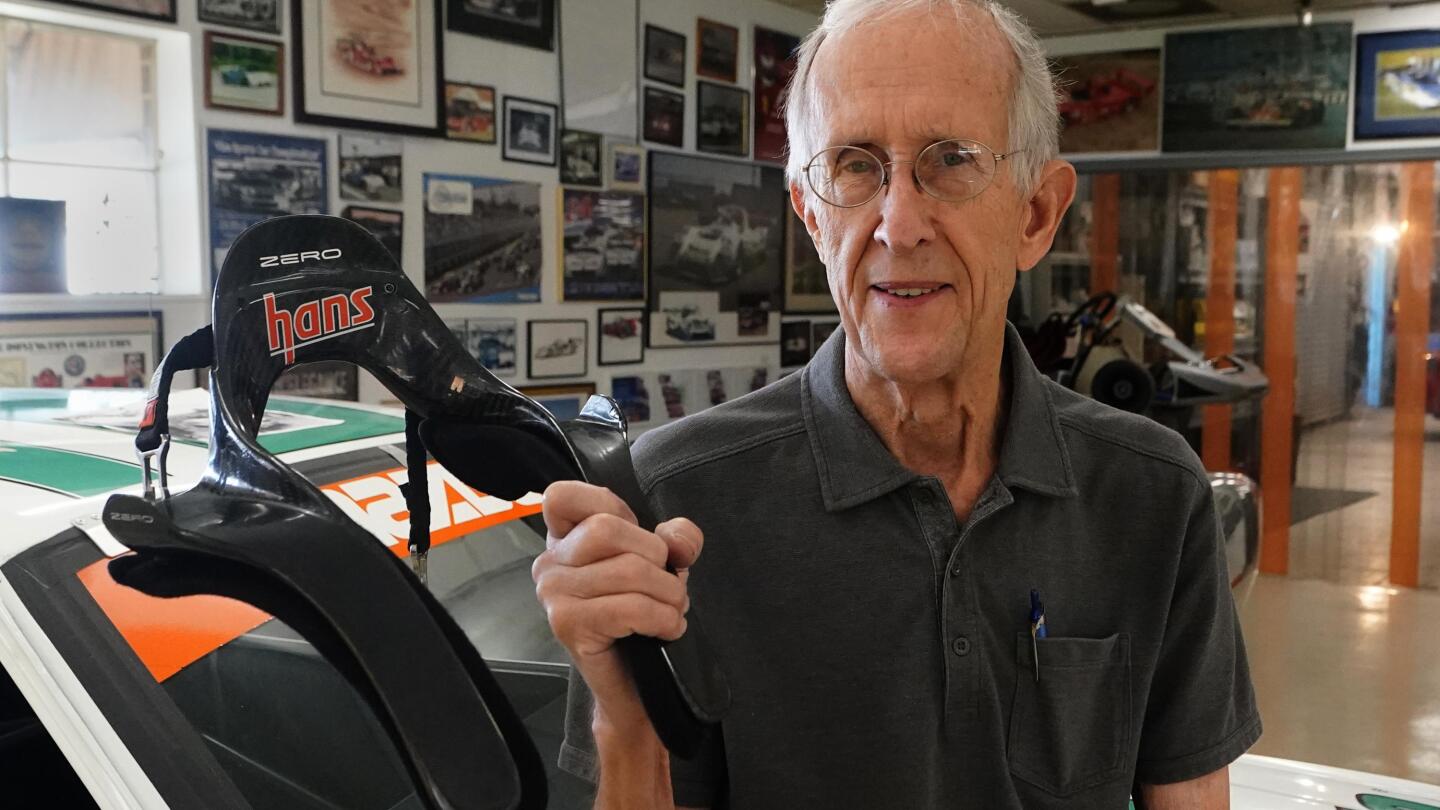The HANS Device looks like this & it is meant to be worn by Racing Drivers around the Head & Neck with the Racing Helmet.

& they restrain the head & neck on the racing helmet.

I also know the Helmets like the ones used in NASCAR, should look like this.

They are meant to be worn around the head like the Motorcycle Helmet from makehuman.
Similar Example

Did anyone make the Auto Racing Helmet with HANS Device yet?
& here's one intresting fact about the HANS Device, It was invented by 2 men named Dr. Robert Hubbard (1943–2019) & Jim Downing.


That Head & Neck Restraint is made by those 2 men.
Here's a history lesson
& there are Notable race car drivers who died from basilar skull fractures include:
Formula 1 driver Roland Ratzenberger in the 1994 San Marino Formula One Grand Prix.
IndyCar drivers Scott Brayton, Bill Vukovich and Tony Bettenhausen
NASCAR drivers Adam Petty, Kenny Irwin Jr., Terry Schoonover, Grant Adcox, Neil Bonnett, John Nemechek, Dale Earnhardt, J. D. McDuffie, and Clifford Allison
ARCA driver Blaise Alexander
CART drivers Jovy Marcelo, Greg Moore, and Gonzalo Rodriguez
Trans Am, Sports Car Club of America (SCCA) driver Jim Fitzgerald
While death from such injuries is usually immediate, some drivers have survived basilar skull fractures, such as NASCAR's Larry Pollard, Ernie Irvan, Stanley Smith, Rick Carelli and F1's Philippe Streiff.
Hubbard had extensive experience as a biomechanical crash engineer, including in General Motors' auto safety program. His first prototype was developed in 1985, and in crash tests in 1989 – the first to use crash sleds and crash dummies using race car seat belt harnesses – the energy exerted on the head and neck was lowered by approximately 80%. Prior tests had established the thresholds for acute basilar skull fracture to be 740 lbs of vertical neck tension and 700 lbs of forward neck shear; the HANS device greatly reduced both these values to 210 lbs. Neck compression was also reduced by about 28 millimetres.
After major racing safety companies declined to produce the product, Hubbard and Downing formed Hubbard Downing Inc., to develop, manufacture, sell and promote the HANS in 1990. However, the product languished until 1994, when Formula One showed interest in the wake of the deaths of Roland Ratzenberger and Ayrton Senna. In 1999, CART driver Gonzalo Rodríguez was killed after suffering a basilar skull fracture in a crash. At the same time, Mercedes was completing research of the HANS on behalf of the FIA for Formula One, finally deciding that it out-performed their airbag project.
The device was first adopted by the National Hot Rod Association (NHRA) in 1996, following the death of Top Fuel driver Blaine Johnson, though was not mandatory in the series until 2004, after the death of 2003 Top Fuel Rookie of the Year Darrell Russell, who was killed by flying debris during the Sears Craftsman Nationals in Madison, Illinois. Other racing series were also slow to follow suit. Many drivers, including seven-time NASCAR Cup Series Champion Dale Earnhardt, resisted the HANS devices or anything that was similar to them, claiming that they were uncomfortable and more restrictive. There were also fears that it would cause more injuries and problems than it prevented. Some even stated that the positioning of the device made the seat belts feel less secure or rubbed on the shoulders or the collar bone. Earnhardt referred to the device as "that damn noose", claiming the tethers would more likely hang him than save him in the event of a crash.
On February 18, 2001, Dale Earnhardt was killed on the last lap of the Daytona 500. Earnhardt was the fourth NASCAR driver killed by basilar skull fractures in an eight-month span, following Adam Petty in May 2000, Kenny Irwin Jr. in July 2000, and Tony Roper in October 2000. While it is still debated whether Earnhardt's death was the result of a broken seat belt or an inadequate head and neck restraint, he died of a basilar skull fracture, which likely would have been prevented by the proper use of belts and a head and neck restraint.
Media members immediately turned focus to the HANS device after Earnhardt's death. HANS device co-founder Hubbard was quoted:
"... (I was) shocked by that. I recorded about 80 entries in my telephone log the first day [after the fatal accident]. And I didn't even write them all down. I was on national television ten times that Monday. I had been down in Florida and came home on Friday and went cross-country skiing in Michigan. So, I didn't know he died until I got home and there was a voicemail on my answering machine at 10 o'clock at night. I actually had two interviews that night before I went to bed."[3]
Even after Earnhardt's death, use of the HANS device or similar products was resisted. The following weekend, Mark Martin said at Rockingham, "I would not wear one for anything. I'll just keep my fingers crossed and take my chances".
Following an extensive investigation into Earnhardt’s death that ended in August 2001, NASCAR did not make any immediate changes regarding use of HANS. Then on October 4, 2001, in an Automobile Racing Club of America (ARCA) race being held in conjunction with the fall NASCAR racing weekend at the Charlotte Motor Speedway, Blaise Alexander was killed in a two-car incident while battling for the lead in the final laps of the race. Coincidentally, the other driver racing with Alexander for the lead was Dale Earnhardt's oldest son Kerry Earnhardt. The younger Earnhardt's car flipped on its roof after Alexander went into the wall, but he was in the lead when the race was halted with four laps to go. Due to carnage of the accident, the race was never restarted, so Earnhardt was declared the winner. NASCAR mandated use of the HANS device in its top three series on October 17, 2001.
Formula One mandated HANS devices in 2003 after extensive testing by Mercedes from 1996 to 1998, sharing the results with other Fédération Internationale de l'Automobile (FIA) affiliates. Using that information, CART made the device compulsory for oval tracks in 2001, and subsequently requiring the HANS devices for all circuits the following season. Starting in October 2001, NASCAR mandated the use of either the HANS or Hutchens device, changing to the HANS device exclusively starting in 2005. ARCA also followed suit in the wake of Alexander's death. The World Rally Championship and Australian V8 Supercar Series made the device compulsory for drivers in the 2005 season.
Acceptance by drivers was helped by the addition of quick-release shackles developed and implemented by Ashley Tilling. They were sourced from the marine industry, being used on racing sailboat rigging. The shackles allowed the drivers a simple and quick pull to release the HANS device and exit their vehicle. The first driver to utilize them was NASCAR driver Scott Pruett of PPI Motorsports. Such shackles were also used on the Hutchens device and others.
Beginning in July 2007, many sanctioning bodies have approved any head-and-neck restraint that passes the SFI Foundation Specification 38.1 standard. These include the HANS device, the Moto-R Sport, the R3, the Hutch-II, the Hutchens Hybrid, or the Hybrid X.
Today, most major auto racing sanctioning bodies mandate the use of head and neck restraints; the FIA has made HANS devices use compulsory for all International-level events from the beginning of 2009. Even monster truck drivers use the HANS device in many events. Grassroots Motorsports awarded the HANS device the Editors' Choice award in 2002. Autosport magazine also awarded HANS their pioneering and innovation award in 2007.
In 2016, Hubbard and Downing, along with FIA's Hubert Gramling, were awarded the initial "SAE International Award for Motorsport Safety Honoring John Melvin" for their lifesaving work on the HANS Device.
